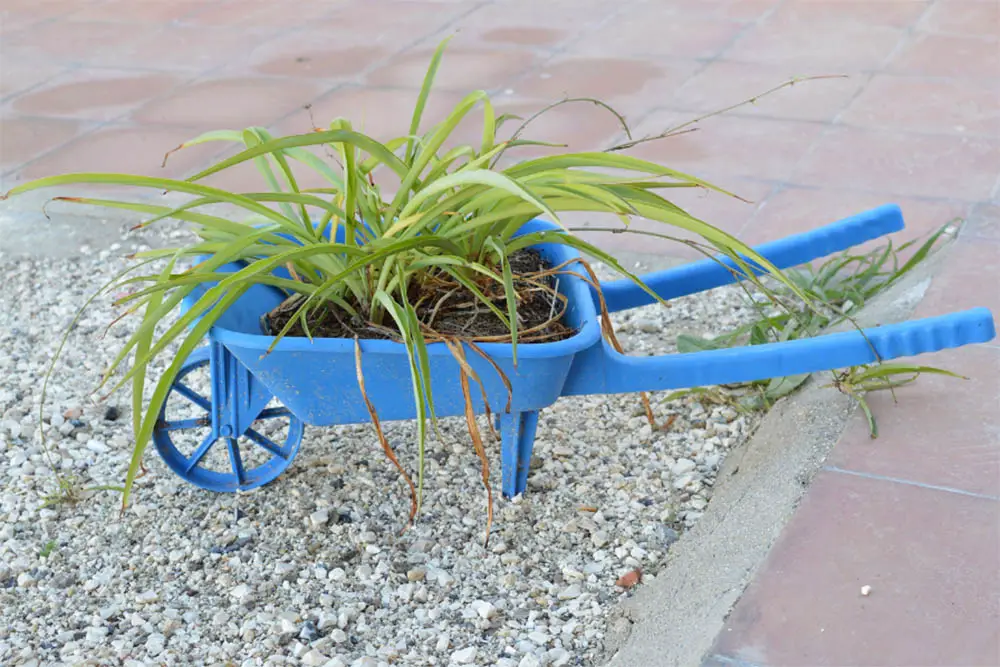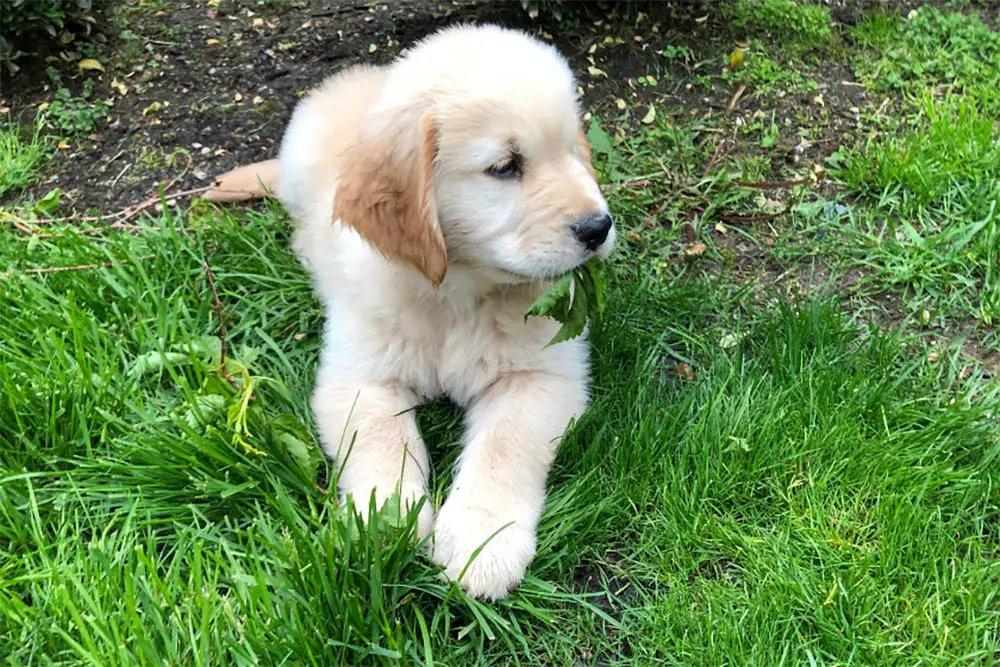The trend for house plants has seen a rise in recent years, and one of the most common house plants you’ll find in homes all over the world is the Spider plant, Chlorophytum comosum. Their long, flowing leaves make them architecturally interesting, but they also make them a target for curious dogs!

Whether you’ve come home to find that your dog has been chewing the leaves of your spider plant or you’re thinking about adding one to your collection, you’ll need to know if they are toxic to dogs.
Below, we’ll take a look at how poisonous spider plants are to dogs. You’ll also find some advice on how to stop your dog from chewing on the leaves of your spider plant.
Are Spider Plants Toxic to Dogs?
Let’s cut straight to the chase. Spider plants are not known to be toxic to dogs. This means that if your dog has eaten any, it’s highly unlikely that it will do them too much harm.
However, as with all plants, whether they are toxic or not, there is a chance that eating the leaves of a spider plant can lead to vomiting and diarrhea.
So, while spider plants aren’t toxic to dogs, they could still cause an upset stomach.
If you’ve noticed that your dog is being sick after eating the leaves of your spider plant, there is an obvious cause for concern. However, it doesn’t necessarily mean that they are having a toxic reaction to it.
Instead, it could be due to the fact that the chemicals found in the leaves of a spider plant are closely related to opium!
The levels of these chemicals are very small, but they are still enough to potentially cause vomiting or diarrhea.
Despite the trace amounts of opium, there is also no evidence to suggest that the leaves of a spider plant have a psychedelic effect on dogs. This means that there is no need to worry about them getting high if they’ve been chewing on your spider plant, either!
However, it’s a good idea to keep your spider plants out of your dog’s reach as much as possible. And, if you’ve found they’ve eaten the entire spider plant, it would be a good idea to consult a veterinarian just to be on the safe side.
Why is my dog chewing on my spider plant?
There are a few reasons why your dog might be chewing on your spider plant. To begin with, they could be mistaking it for grass.

Dogs eat grass as a way of curing an upset stomach and clearing out their system by being sick. And, since a spider plant looks a lot like long strands of grass hanging from the air, it’s easy for a dog to assume that that’s exactly what it is.
They could also be attracted by the smell of the spider plant. This isn’t something that humans are able to pick up on, but since dogs have such an amazing sense of smell, it might be something that they find irresistible and want to explore further by chewing it.
Finally, there’s a chance that your dog is chewing on your spider plant simply because they are bored.
This could be especially true if your dog has been left alone for a long period of time and you’ve not given them enough toys to keep them occupied.
Likewise, if they haven’t had an adequate amount of exercise before being left alone, they might be destroying your spider plant as a way of burning excess energy.
How do you stop a dog from eating a spider plant?
If you’ve given your dog lots of exercise and offered them a good variety of toys to play with, but you find they are still insisting on destroying your spider plants, there are a few ways you can stop them.
The first option you have is to use a spray deterrent. This isn’t for your dog; it’s for your spider plant!
Simply coat the leaves with the bitter-tasting spray, and your dog will soon learn that chewing on your spider plant leaves a nasty taste in the mouth.
You can also try pruning the leaves of your spider plant to keep them out of your dog’s reach. They’ll also look less like long strands of grass if you do this, which reduces the chances of them mistaking your spider plant for something that will help cure their upset stomach.
You might think that the toys you’ve given your dog are enough to keep them occupied, but perhaps you’ve not found the right toy yet. It’s all very well giving them something that can destroy, but this doesn’t keep them mentally active. Try giving them a treat-puzzle toy while you’re out of the house.
They’ll be so occupied with trying to get to the delicious treats in the center of it that they’ll likely forget your spider plant even exists!
Sometimes the simplest method is the most effective, and placing your spider plant out of your dog’s reach is all it takes to stop them from chewing on them.
You could even hang them high from the ceiling to keep them out of the way but still enjoy their long, luscious tendrils.
Which houseplants are toxic to dogs?
So, we know that spider plants aren’t toxic to dogs. But, if, like many people, you’ve got a collection of exotic-looking houseplants (or you’re planning on starting one), it’s a good idea to know which houseplants are poisonous to dogs.

Below, you’ll find a list of houseplants that are toxic to dogs. If at all possible, you should avoid adding these to your collection if you have a dog. Or, at the very least, you should make sure that they are placed well out of their reach.
- Aconitum
- Amaryllis bulbs
- Asparagus fern
- Azalea
- Cyclamen
- Daffodil bulbs
- Daylilies
- Delphiniums
- Foxgloves
- Hemlock
- Hibiscus
- Hostas
- Hyacinths
- Hydrangeas
- Ivy
- Laburnum
- Lily of the valley
- Lupins
- Morning glory
- Nightshade
- Oleander
- Rhododendron
- Rhubarb leaves
- Sweet peas
- Tulip bulbs
- Umbrella plants
- Wisteria
- Yew
How do I repair my spider plant after my dog has chewed it?
If you’ve walked into a room filled with spilled soil, chewed leaves, and a dog with a guilty look on its face, you might think that your spider plant is now beyond repair. However, this isn’t necessarily the case.
As with all plants, the life force lies in the roots. So, even if your dog has chewed the leaves right down to the base of the plant, there’s a good chance that it will grow back strongly, given enough care and attention.
In this case, you simply need to give it some water and place it in a sunny position. You also need to make sure that it’s well out of your dog’s reach.
If not, you run the risk of it happening all over again once those irresistible-looking leaves have grown back!
If your dog has chewed the leaves, but they are still attached to the roots, you’ll need to do a little pruning to give your plant a good chance of surviving.
If damaged leaves are left unpruned, there is a higher risk of pests and diseases getting to them and potentially killing the entire plant.
Prune each of the damaged leaves with a pair of clean, sharp secateurs or scissors. Make your cut about 1cm below the damaged part of the leaf, and cut them at an angle.
This doesn’t only imitate the natural look of the plant, but it helps create a cleaner cut that the plant will be able to heal faster.
Dog urine and spider plants
If you find that your dog is more prone to lifting a leg and urinating on the leaves of your spider plants while you’re out of the house than they are chewing them, there are still a couple of things you can do to stop this from happening.
Again, the best option is to hang them as high as possible. If your dog can’t reach them, then they won’t be able to relieve themselves on them! You can also try pruning the leaves back to keep them out of your dog’s reach.
This is quite an important thing to do if your dog is urinating on your spider plants, as the nitrogen content in dog urine can cause leaf burn. It can also kill your spider plants if it happens regularly.
Conclusion
The most important thing to take away from this is that spider plants are not toxic to dogs. If they’ve been chewing on the leaves, the most they’ll suffer from is an upset stomach and vomiting or diarrhea.
Even if they’ve managed to gobble down an entire spider plant, there’s a very small chance that they’ll show any signs of being poisoned. However, in this case, it’s always best to check with a veterinarian.
As is the usual case with dogs, prevention is the best cure. Keep your spider plants out of their way, and they will find it much harder to reach them.
They might also completely forget that they are there after a while. If you find that they are chewing your spider plants when you’re out of the house, make sure that they are well-exercised before you leave, and give them plenty of engaging toys to play with.
This will stop them from getting bored and becoming destructive.
